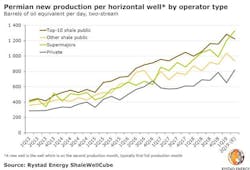Pessimism about well productivity in the Permian basin is premature, according to Rystad Energy.
Analysis by the firm refutes observations that average oil and gas well performance is declining, which are based on assumptions about depletion of core inventory, growth in the share of child wells, and well-spacing challenges (OGJ Online, Aug. 1, 2019).
“We do not find sufficient evidence in the data to support these speculations,” said Artem Abramov, Rystad’s head of shale research. “We conclude that the average new production per well in the basin matches the all-time highs seen in early 2019 despite depletion concerns.”
Rystad treats new production as that of the second months of wells, typically the first full months of output and usually peak production for unconventional wells.
“A typical horizontal Permian well currently produces approximately 830 b/d of oil during its second month of production, which is an all-time high level,” Abramov said.
For the first time since 2014-15, large major oil companies might have shot past the top 10 public exploration and production companies in new production per Permian horizontal well in the second quarter this year, Rystad said.
The top 10 E&P companies historically have been several quarters ahead of the industry in well productivity because of their early entry into the basin, fast learning due to scale, and advantage in high-grading opportunities with acreage size.
Average perforated lateral length, important to well performance, increased to 8,500 ft in the second quarter of 2019 from 5,000 ft in the first quarter of 2013.
Normalizing new production per horizontal well to an 8,000-ft well design shows “significant structural improvements in average normalized productivity happened from 2013 to 2016,” Rystad said.
The following 2 years showed less improvement as Permian activity increased with much new production coming from less-mature acreage.
“We have been observing a new period of improvement since the second half of 2018 as a result of high-grading in the current capital-discipline environment and an increasing share of acreage moving into the field development mode,” Abramov said.
